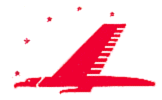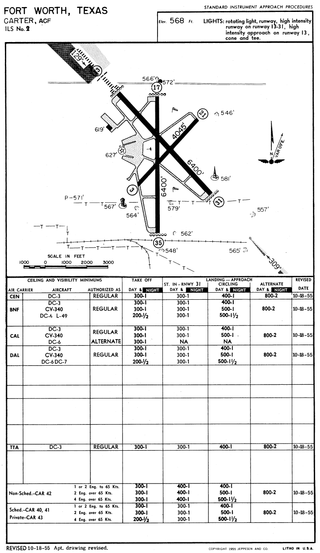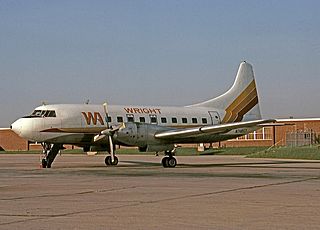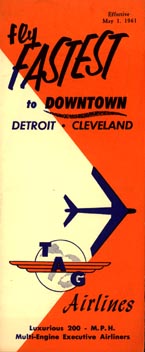Texas International Airlines Inc. was local service carrier in the United States, known from 1940 until 1947 as Aviation Enterprises, until 1969 as Trans-Texas Airways (TTA), and as Texas International Airlines until 1982, when it merged with Continental Airlines. It was headquartered near William P. Hobby Airport in Houston, Texas.

Capital Airlines was a United States trunk carrier, a scheduled airline serving the eastern, southern, southeastern, and midwestern United States. Capital's headquarters were located at Washington National Airport across the Potomac river from Washington, D.C., where crew training and aircraft overhauls were also accomplished. In the 1950s Capital was the fifth largest United States domestic carrier by passenger count after the Big Four air carriers.
Marquette Airlines was a brief-lived trunk air carrier, a United States scheduled airline that operated between St. Louis to Detroit from 1938 to 1940 before merging into Transcontinental & Western Air (TWA).

Billings Logan International Airport is in the western United States, two miles northwest of downtown Billings, in Yellowstone County, Montana. It is the fourth largest airport in Montana, having been surpassed in recent years by Bozeman, Missoula, and Flathead County (Kalispell) in both number of gates as well as annual enplanements. Owned by the city of Billings, the airport is on top of the Rims, a 500-foot (150 m) cliff overlooking the downtown core, and covers 2,500 acres of land.
Air Ontario Inc. was a Canadian regional airline with its predecessor initially headquartered in Sarnia and later in London, Ontario. In 2002, Air Ontario became Air Canada Jazz.
Ozark Air Lines was a local service carrier in the United States that operated from 1950 until 1986, when it was purchased by Trans World Airlines (TWA). In 2001, TWA was merged into American Airlines. A smaller regional airline that used the Ozark name operated in 2000–2001. From 1950 until 1986, Ozark's headquarters was located at St. Louis Lambert International Airport.

Cheyenne Regional Airport is a civil-military airport a mile north of downtown Cheyenne, in Laramie County, Wyoming. It is owned by the Cheyenne Regional Airport Board.
Memorial Field Airport is located in City of Hot Springs, in Garland County, Arkansas, United States, 3 miles (4.8 km) southwest of Downtown Hot Springs. It serves nearby Hot Springs National Park. The airport is used for general aviation; airline flights are subsidized by the federal government's Essential Air Service program at a cost of $1,637,012.

Juneau International Airport is a city-owned, public-use airport and seaplane base located seven nautical miles northwest of the central business district of Juneau, a city and borough in the U.S. state of Alaska that has no direct road access to the outside world. The airport serves as a regional hub for all air travel, from bush carriers to major U.S. air carriers such as Alaska Airlines.

Cleveland Burke Lakefront Airport is a city-owned airport on the shore of Lake Erie, in the northeast part of downtown Cleveland, Ohio, United States. It's classified as a general aviation airport and is an FAA designated reliever to Cleveland Hopkins International Airport (CLE), which is Greater Cleveland's primary airport. In 2018, based on FAA data, Burke Lakefront was the seventh busiest airport in the state of Ohio. It is named after former Cleveland mayor and U.S. senator Thomas A. Burke.

Greater Southwest International Airport, originally Amon Carter Field (ACF), was the commercial airport serving Fort Worth, Texas, from 1953 until 1974. Dallas/Fort Worth International Airport opened in 1974 a few miles north to replace Greater Southwest and Dallas Love Field as a single airport for the Dallas-Fort Worth Metroplex. The area is now a commercial/light-industrial park serving DFW International, centered along Amon Carter Boulevard, which follows the old north-south runway.

Annette Island Airport is located on Annette Island in the Prince of Wales – Hyder Census Area of the U.S. state of Alaska. It is located 5 nautical miles (9 km) south of Metlakatla, Alaska. The airport was established as the Annette Island Army Airfield during World War II and initially served as a military airbase.

Midway Airlines was a United States airline based in Chicago, Illinois. It was incorporated on October 13, 1976, by Kenneth T. Carlson, Irving T. Tague and William B. Owens, filing with the Civil Aeronautics Board (CAB) for an airline operating certificate. Although it received its operating certificate from the CAB prior to the passage of the Airline Deregulation Act in 1978, it was viewed as the first post-deregulation start-up. The airline commenced operations on November 1, 1979.

Northeast Airlines was an American trunk carrier, a scheduled airline based in Boston, Massachusetts that chiefly operated in the northeastern United States, and later to Canada, Florida, the Bahamas, Los Angeles and other cities. It was acquired by and merged into Delta Air Lines in August 1972.

American Overseas Airlines (AOA) was an airline that operated between the United States and Europe between 1945 and 1950. It was headquartered in Midtown Manhattan, New York City.

Greater Portsmouth Regional Airport is on State Route 335 in Minford, Ohio, 12 miles northeast of Portsmouth, in Scioto County, Ohio. It is owned by the Scioto County Airport Authority. The National Plan of Integrated Airport Systems for 2011–2015 categorized it as a general aviation facility.

Bonanza Air Lines was a local service carrier as defined by the federal Civil Aeronautics Board) in the Western United States from 1945 until it merged with two other local service airlines to form Air West in 1968. Its headquarters was initially Las Vegas, Nevada, and moved to Phoenix, Arizona in 1966.

Trans Caribbean Airways (TCA) was an irregular air carrier until 1957, when it was certificated by the Civil Aeronautics Board (CAB) as an international air carrier to fly from New York City to San Juan, Puerto Rico. TCA thereafter operated as a small scheduled airline specializing in flying from New York to the Caribbean, adding a small number of additional routes over time until it was purchased by American Airlines in 1971.

Wright Air Lines, founded in Cleveland, Ohio in 1966, is regarded as the first United States regional airline. The airline was based in Cleveland at Burke Lakefront Airport and filed for protection under Chapter 11 of the Bankruptcy Code in September 1984. Its assets were liquidated within a year.

Soldotna Airport is a city-owned, public use airport located one nautical mile (1.85 km) southeast of the central business district of Soldotna, Alaska.

















